
At some point, it is very likely that a sanctuary will find itself in need of outside help. Whether it comes to tasks ranging from building a structure to getting help with social media posting, independent contractors can be a very important asset to accomplishing your sanctuary’s work. It is however critical to make sure that you understand the differences between an independent contractor and an employee, which is discussed in depth in our resource on that issue here.
IRS scrutiny on the question of nonprofitsNon-governmental organizations whose primary purpose is something other than selling goods or services. inadvertently “misclassifying” employees as independent contractors has been heightened recently. The result of being caught in such a mistake can mean your sanctuary could be liable for back wages, unemployment taxes, and other penalties. While there is no panacea for this issue, having a solid understanding with your outside workers in the form of a written contract can go a long way to ensuring that their role with you is understood to be that of an independent contractor, and not that of a de facto employee.
Need An Independent Contractor Agreement? Look No Further!
The Open Sanctuary Project has developed a free downloadable template of an Independent Contractor Agreement, which you can download here. This template is customizable and modifiable with options to best fit your sanctuary’s needs! In order to help you make sense of the many elements of this contract, keep reading this resource to access two hypothetical “sample” independent contractor agreements, which can help demonstrate how you can tailor this form to your needs. We hope that these resources and this document will help you not only with independent contractor agreements, but also to help understand contracts better in general!
Because we know that legal templates and contracts can be intimidating (and yes, very boring), below we will “break down” the elements of our Independent Contractor Template for you and explain how the various options work using our Template, Hypotheticals and Sample Contracts. To start, we will introduce you to our two hypothetical sanctuaries and their potential independent contractor hires, all located in the lovely fictional state of Winnemac. As you go through our breakdown, you may find it useful to look at our Template and Samples side by side. Again, hopefully, this breakdown will help you not only with contracts in the context of an independent contractor agreement, but also with understanding contracts generally, in particular when it comes to that inevitable confusing “boilerplate language!”
Professional Legal Assistance Is Recommended!
All that said, it is always worthwhile having your local counsel take a look at any written agreement you make, so that you’re sure your contract complies with all quirks and foibles that may be unique to your particular jurisdiction, and that it is best fitted to your own sanctuary’s unique needs!
Hypothetical 1: Telling Goat Stories

Access and download the sample Go Go Goats contract here!
Gertie Goatfriend is the fictional main caretaker of five disabled goats at their microsanctuaryA microsanctuary is a small scale community of human and nonhuman (generally “unconventional or farmed”) animal companions, who live together in a chosen shared lifestyle and in commitment to ending the oppression of all beings. Microsanctuaries adhere to the notion that no nonhuman member of the community should “serve a purpose.” Microsanctuaries can exist in any context: rural, suburban, or urban. A microsanctuary can consist of as small a community as one animal and one human caregiver. For more information on microsanctuary please refer to the Microsanctuary Resource Center., Go Go Goats. Go Go Goats is an unincorporated association. Gertie is extremely dedicated to the day-to-day direct care of their goats, but is also passionate about telling the goats’ stories. Some of their goats have come from dairy farmsFor-profit organizations focused on the production and sale of plant and/or animal products., one from a petting zoo, and one was a slaughterhouse escapee, so Gertie feels it is important to share their backgrounds and unique personalities with the public. They have researched social media strategies and concluded that, while they really want to do social media posts to tell the Go Go Goats’ resident stories, they need help with this due to the significant amount of work involved with the direct care of their goats. Luckily, they have a friend, Sally Social, who runs a small marketing LLC. Sally really likes goats and she is very skilled at crafting compelling social media posts with great photos and narratives. Sally has loads of clients but agrees to do a weekly social media post for Go Go Goats on three platforms at a discounted hourly rate.
Powered By EmbedPress
Hypothetical 2: Building a New Structure for Turkeys

Access and download the sample Turkey Love Sanctuary contract here!
Buddy Birdlover is the fictional executive director of a small 501(c)(3) registered sanctuary for turkeysUnless explicitly mentioned, we are referring to domesticated turkey breeds, not wild turkeys, who may have unique needs not covered by this resource. called TurkeyUnless explicitly mentioned, we are referring to domesticated turkey breeds, not wild turkeys, who may have unique needs not covered by this resource. Love Sanctuary. He’s very excited to welcome four new young large breed turkey residents mid-November, but he needs to build a new residence for them. Buddy has researched how to create the best indoor space for turkeys, so he has a good idea of what kind of space he needs to give them so that they have the best home possible. However, he’s not so sure about materials and building. While he loves his turkeys, building materials and construction are not his thing, and he really just wants to dictate his specifications to someone who can build what he is envisioning. He was excited when he heard about Belinda Builder, a local builder with a reputation for making quality housing for birds, including turkeys. He reaches out to her, and they agree to work together with Belinda taking care of all design, purchasing of materials, and doing the construction at a set price. They memorialize the terms of their contract in the document above.
Powered By EmbedPress
Breaking it Down: Understanding an Independent Contractor Agreement Section by Section
Preamble

The preamble of a contract identifies the name of the agreement, the date of execution, the parties involved, their addresses, as well as what kind of entities they are. In our Sample Contracts, you easily find all the information you might need about any party to the agreements right in the preamble.
Recitals
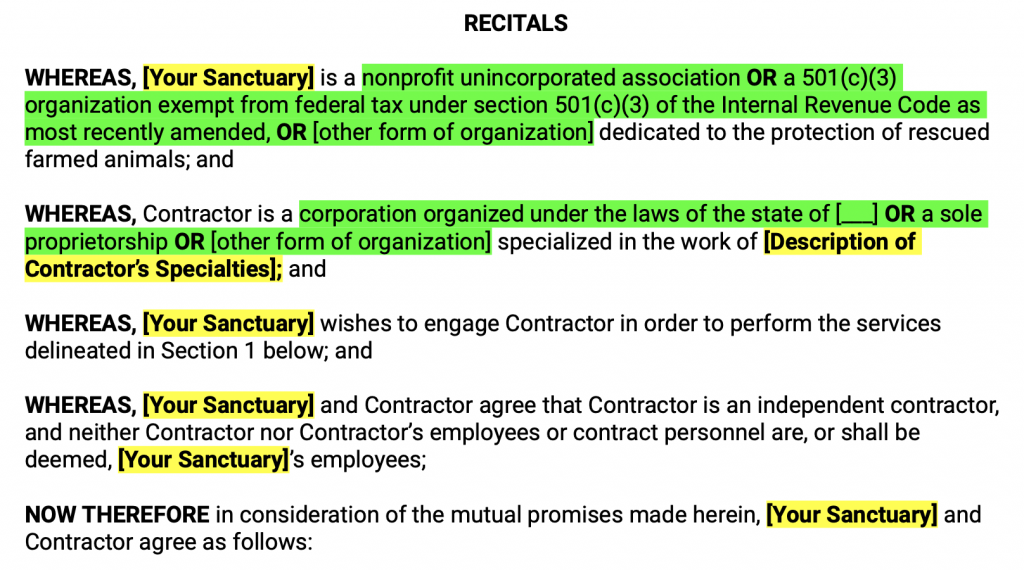
Recitals, also known as “Whereas” clauses, are not required in a contract, and they are not “legally operative” in the sense that they create rights or obligations. However, they serve a really important purpose in terms of providing a background “narrative” to the agreement. They can speak to the parties’ mutual understandings when they enter into the agreement. While they are not “enforceable” per se, in the event that the contract must be construed by a third party such as a mediator, an arbitrator, or a court, they can be helpful in determining the intentions of the parties.
Note that our Template recitals explicitly provide that your sanctuary and your contractor “agree that Contractor is an independent contractor, and neither Contractor nor Contractor’s employees or contract personnel are, or shall be deemed…employees.” While this language will not definitively establish an independent contractor relationship, it certainly helps to lay a foundation that the intent of the parties in establishing the agreement was to do so.
Recitals also serve other important purposes. In Go Go Goats’ Agreement with Sally Social, the recitals include a note that Go Go Goats is “interested in sharing the stories of their goat residents as a means of educating the larger public about goat personalities, proper goat care, as well as the larger plight of goats within industrialized farming systems,” and that Sally “has a special interest in animal welfarePractices and policies that promote the well-being of nonhuman animals, specifically their health and comfort. and specifically goats, and in promoting the welfare and well being of goats generally.” This sets a very different tone than an agreement with generic recitals, or no recitals at all. It makes it clear that the animals are centered in both parties’ minds.
Note also that in Turkey Love Sanctuary’s Agreement with Belinda Builder, the recitals mention Buddy’s missionThe stated goals and activities of an organization. An animal sanctuary’s mission is commonly focused on objectives such as animal rescue and public advocacy. of providing turkeys with “loving and compassionate care for the entirety of their lives,” and Belinda’s specialization in “designing and building predator proofed, secure and healthy homes.” In this way, the recitals create a contextual narrative that shows high standards of care for turkeys matter to both parties.
In addition to setting a context for legal understanding, recitals are a special way for you to share your organizational goals and narratives with your contractors, as well as embracing their special skill sets. Consider how you can use recitals to make our Template your own!
Section 1: Services To Be Performed

In this Section, you will describe the services that you are engaging your independent contractor to perform. It is best to be as explicit and detailed as possible here. Using language that is descriptive both in scope and in time is helpful. You can see what we mean by this by looking at our samples!
For example, Go Go Goats’ contract with Sally Social contemplates a two part process: first, an initial visit by Sally to Go Go Goats, and then weekly posts that are made with the photos and background that Sally gathers on her initial visit. Another thing to consider with respect to the Go Go Goats contract is that it is set to a limit of eight posts total for now, so that Gertie can assess at the completion of that work whether they feel like it has been a positive and enhancing experience for their sanctuary, or whether they’d like changes made to their agreement. If so, they can create a new agreement with Sally based on what they’ve learned.
When it comes to Turkey Love’s contract with Belinda, you can note that Buddy describes all of his physical “wish list” for the turkey home, as well as the stages of the process that he would like to follow. The description of the work explains a stepwise process where Belinda will first submit her designs for his approval, and then move on to the actual construction.
Breaking down services in this way can make it easier when it comes to figuring out payment schedules, as we shall soon see!
Section 2: Payment
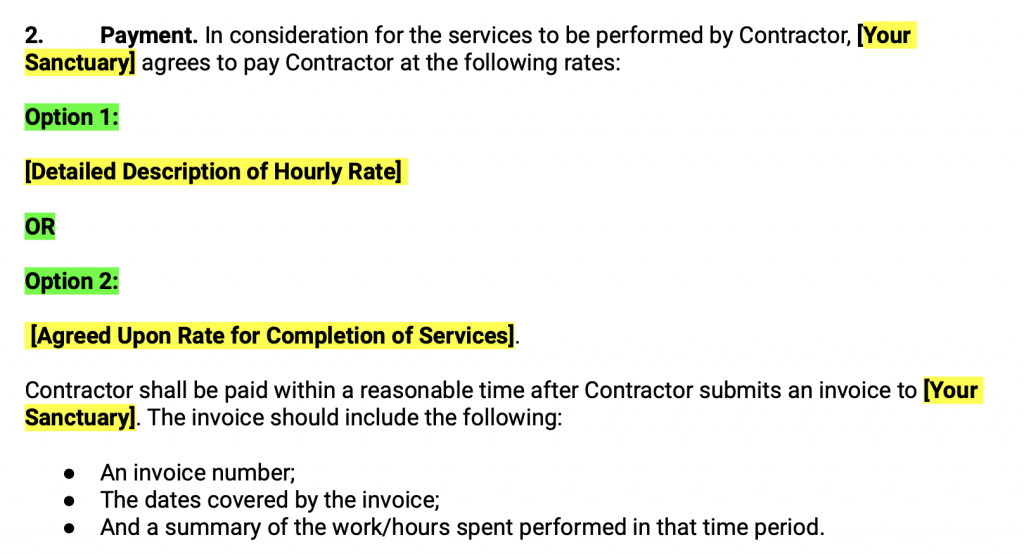
In this section of our Template, you will note that we have offered you two options to choose from in customizing your Agreement. One option contemplates paying your contractor an hourly rate. The second option provides for an agreed upon rate after completion of your contractor’s project. Both options can be useful, as you can see by Buddy’s and Gertie’s choices in our Sample Contracts. And both options can be customized to deal with your particular project and context!
Go Go Goats and the “Hourly Rate”
In the Go Go Goats Sample, note that Gertie has opted to pay Sally Social an hourly fee for her social media services. However, there is nuance to this in two ways. Gertie was very happy to pay for all time spent by Sally on her sanctuary site taking pictures and getting background information on the goats, as they realized that this was critical to giving Sally the material she needed to make great storytelling posts. However Gertie was very concerned about potential ballooning social media expenses associated with weekly social media posts, and wanted to establish a set budget for that, so they wouldn’t have unanticipated expenses. After all, Gertie is always dealing with lots of unanticipated expenses with respect to their residents! So after they talked to Sally about this concern, they mutually agreed that a weekly social media expense cap of $30 Winnebucks for any given weekly post made sense. This really helped Gertie feel comfortable that they have a set limit on spending per week on this particular project. This is a great reminder that it’s very important to air all your concerns and thoughts about your project with your independent contractor well in advance of executing a contract. Chances are, you can come to a mutually agreeable decision, which is much better to do in advance of executing a contract.
Turkey Love and the “Rate Upon Completion”
In the Turkey Love example, you can see that Buddy got his wish for a set price for a finished home. However, he also had worries about having some control over design approval. The way that he and Belinda Builder worked this issue out was to agree on a two part payment of the agreed upon fee. First, Belinda is paid part of her set fee upon submission of her design proposals to Buddy, and then she receives the rest of her payment after the conclusion of construction.
In both situations, you can see how either an hourly rate, or an agreed upon rate upon completion of services can be tailored to your sanctuary’s particular needs. With either choice, you can also see how important it is to maintain good communication about your expectations with anyone that your sanctuary may choose to engage as an independent contractor, or in fact with any kind of contract! These discussions are always best had between the parties openly and in advance of any agreement, and that makes the “putting it in writing” part so much easier!
Section 3: Expenses
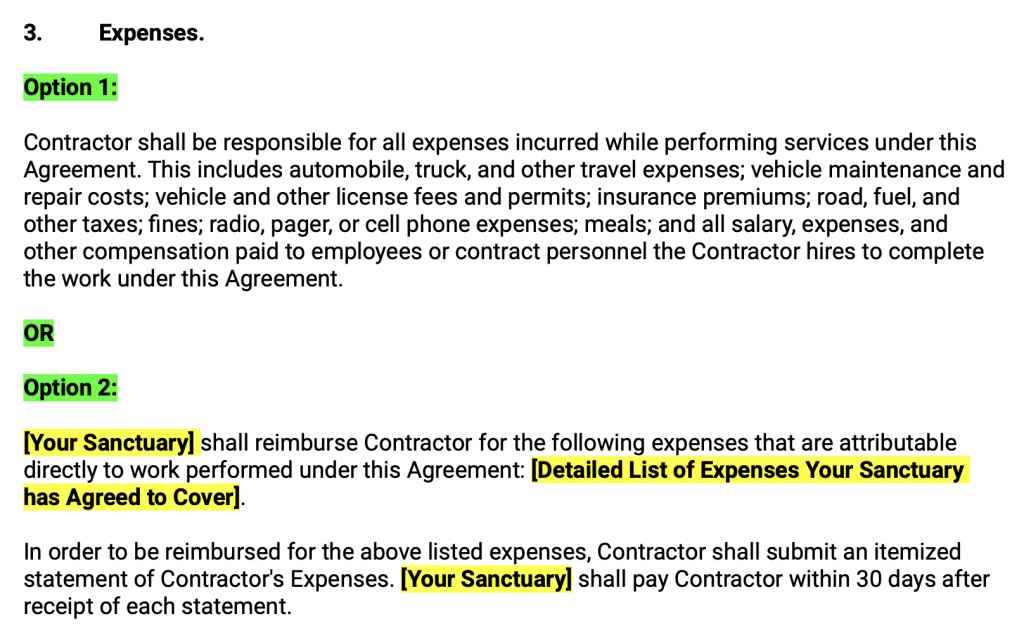
This is another section of our Template that offers you options to customize it based on your own specific needs! When we talk about expenses here, what we mean are the costs that your independent contractor may incur in accomplishing the work that they were engaged to do. These can be fuel, material, or equipment costs among other things. Your sanctuary may choose to negotiate to pay for some, all, or none of those expenses. It all depends on context, so hopefully Gertie and Buddy can help here again in showing how those choices work. Again, Gertie and Buddy have chosen two different options.
Go Go Goats and “Paying Specified Expenses”
Here, because Sally Social lives way across the county from Go Go Goats, Gertie Goatfriend has agreed to pay Sally’s fuel expenses associated with the travel to and from the sanctuary when it comes to the initial visit required to photograph and get background on the residents. To get reimbursed, Sally needs to send Gertie a written notice with the receipt for these fuel expenses, and Gertie must reimburse her within 30 days.
Turkey Love and “No Contractor Expenses Paid”
In the Turkey Love example, because Buddy Birdlover really doesn’t know much about construction materials and expenses and would rather have Belinda handle all that for him, he’s having her cover all of her expenses. Thinking about these things gives him a headache and he’d rather focus on his turkey friends. So they decided together that the final cost of the entire project includes all of Belinda’s expenses, and this section provides that Belinda is also responsible for all other associated expenses with the project, including fuel and auto expenses.
Section 4: Deadline
This is quite a self-explanatory, simple, and easy section for the most part! Just fill in when you’d like your work done. To add some nuance though, let’s consider how Buddy and Gertie have made this section their own.
Go Go Goats and “Deadline”
Go Go Goats’ contract with Sally Social contemplates work regularly completed for a specified time frame. Gertie wants to get a draft social media post at a certain time, and also wants to allow themselves a window to review it and potentially suggest revisions. Sally wants some time to be able to do those appropriately, so what they came up with given their respective schedules is that “Each Weekly Post shall be submitted to GGG for approval by 5:00 PM on the Tuesday of the week that it is to be posted. GGG shall have 48 hours to review and approve the Weekly Post or suggest revisions. Contractor shall have an additional 24 hours to make the proposed revisions and post the Weekly Post.” This makes Gertie feel good because if they have any goat emergencies, they still have a cushion of time to review Sally’s posts. Sally is happy because they also have a cushion to make any additional changes required by Gertie.
Turkey Love and “Deadline”
With Turkey Love’s contract, the deadline is really simple! Buddy wants the work done by November 1st, well in advance of when he knows that his new turkey residents are arriving, just in case any snafus or quirks come up. He’s really smart to think in this way, because he now has a time frame with a buffer built in, just in case for example Belinda comes across some kind of material shortage that she needs to work around.
Section 5: Vehicles and Equipment

Here, both Go Go Goats and Turkey Love have specified that all “vehicles, equipment, tools and materials” used to provide their independent contractors’ services will be furnished by their contractors, and they will not require them to purchase or rent any additional equipment. While this may appear extraneous as a provision, having it in your independent contractor agreement can help establish that you are not exerting either behavioral or financial control over your contractor in such a way as could tip your relationship into an employer/employee relationship. For more on the factors that can determine how your relationship is categorized, again review our resource on independent contractors.
Section 6: Independent Contractor Status
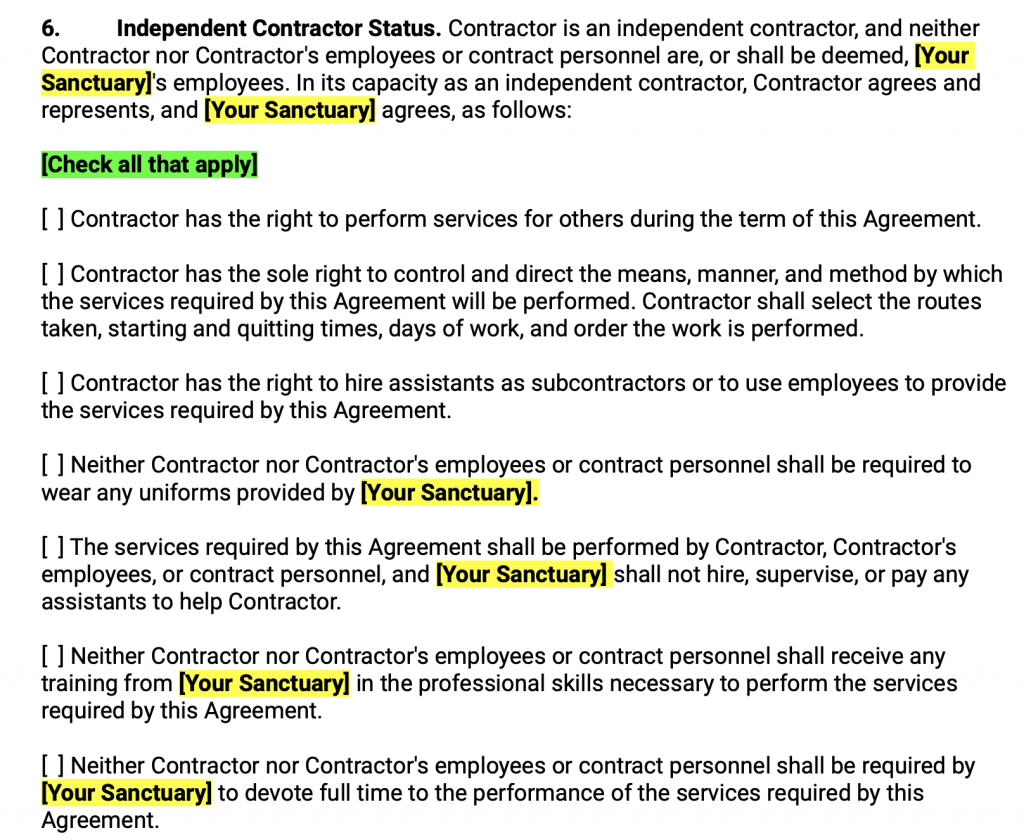
You said it in the recitals, but now you will say it here again! A lot of legal documents are about repetition, repetition, and MORE repetition (which is part of why they’re so boring)! The relationship that both Gertie and Buddy want to establish with Sally and Belinda is that of engaging an independent contractor, NOT that of hiring an employee. So this section re-establishes that understanding and then offers a list of tick boxes that can be checked as applicable.
Each tick box that can be checked here goes towards establishing that your sanctuary is not exerting behavioral or financial control, and reiterates that the relationship between the parties is that contemplated between a sanctuary and an independent contractor, versus that of a sanctuary and an employee. This list is worth reviewing carefully in order to make sure that in your mind, when you are hiring someone, the independent contractor relationship is indeed what you are contemplating, versus someone you might actually be hiring as an employee. If you look at it in the context of our resource on independent contractors, you will see that each tick box addresses some of the factors used to determine whether the hiring sanctuary is disowning the behavioral and financial control required to establish an employer/employee relationship explicitly. Listing them explicitly in your contract in this way also helps to establish that, yet again. Repetition!
Section 7: Business Licenses, Permits, and Certificates

It is very important that you make sure that your independent contractor has all their necessary licensure in place when it comes to their business and work contemplated in your agreement. You can and should request such documentation in advance of entering into an agreement with any contractor. This provision ensures that your contractor is warranting that all of their relevant licensure is in place and current.
Section 8, 9, 10 and 11: State and Federal Taxes, Fringe Benefits, Unemployment Compensation and Workers’ Compensation
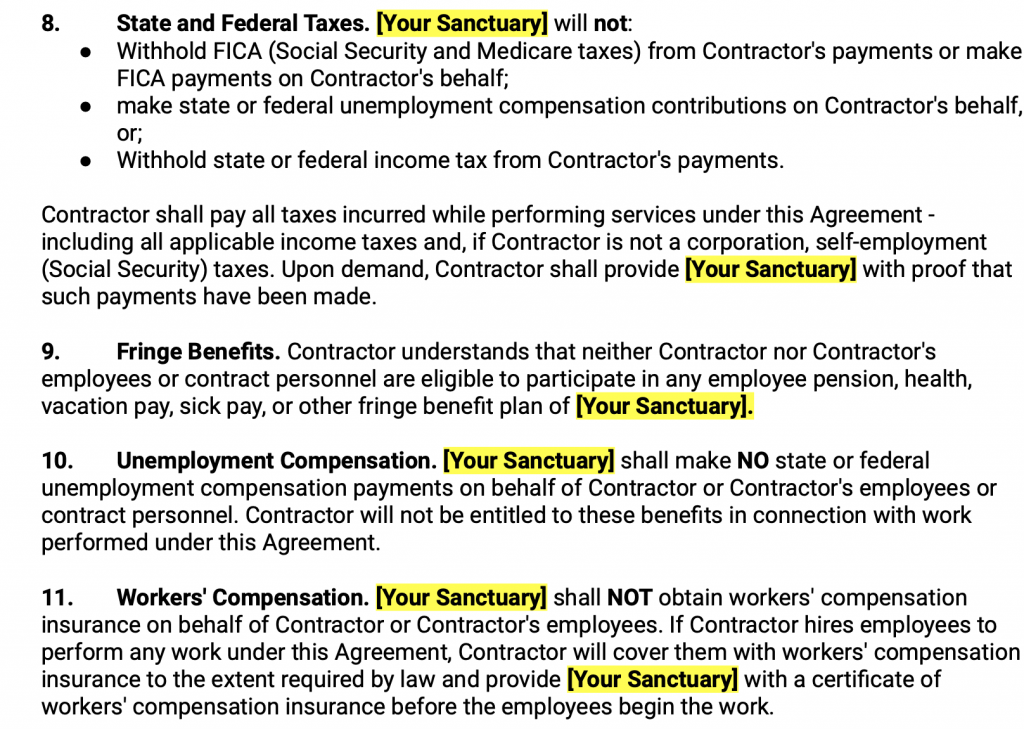
Let’s talk about “boilerplate.” Boilerplate provisions are, for any non-legally oriented person, the parts of a contract that definitely make you want to take a snooze. It is language that can be considered “standard” or “generic”, and so people tend to skip right through that. Again, language in contracts can be repetitive, dry, and often recites detailed specifics in very long winded ways. However, just because it’s considered “standard” or “generic” doesn’t mean this kind of language is unimportant! Specifically in the context of a contract commissioning an independent contract, it’s very important to have the following provisions in place.
Here’s why: These sections all provide that the benefits typically provided to an employee will NOT be provided by your sanctuary, as instead you are hiring your contractor as an independent contractor. Again, this goes towards establishing that your hire is indeed operating as an independent contractor, and NOT an employee. These include:
- Withholding FICA (Social Security and Medicare) taxes;
- Providing any kind of employee pension, health, vacation pay, sick pay, or other fringe benefit plan to your contractor;
- Making state or federal unemployment compensation contributions on behalf of your contractor;
- Withholding state or federal income taxes on behalf of your contractor; and
- Providing insurance coverage of any kind with respect to workman’s compensation for your contractor or their employees.
NOTE that there are provisions in Sections 8 and 11 that specifically pertain to State and Federal Taxes and Worker’s Compensation which both provide that your sanctuary has the right to request from your independent contractor proof that they have complied with all relevant regulations.
Section 12: Insurance
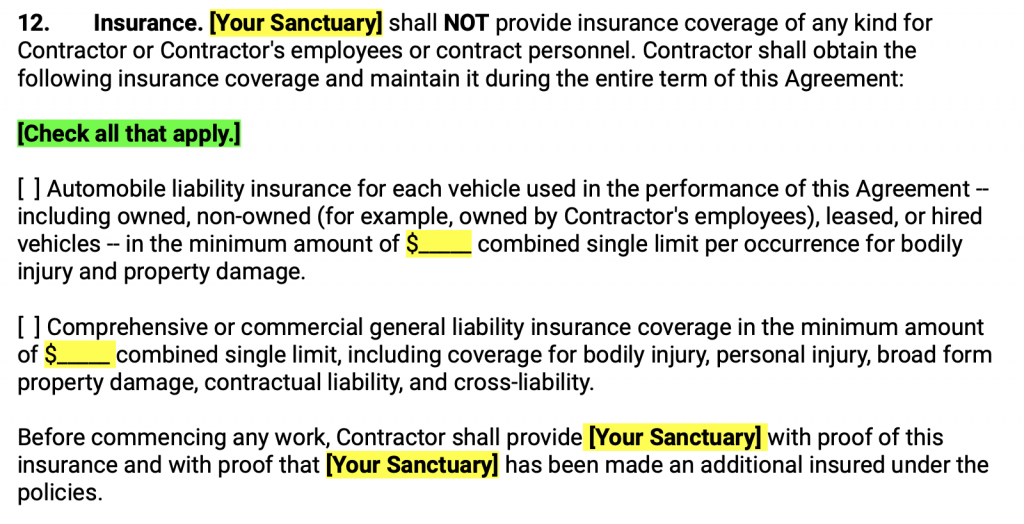
This provision could similarly be considered to be “boilerplate,” but is again important with respect to establishing an independent contractor relationship versus that you might have with an employee. Here we also use tick boxes where you can tick off what is relevant to your sanctuary. Both Go Go Goats and Turkey Love have decided that they want to tick both boxes – they want to make sure that their contractors have insurance coverage, and they want to be named as additional insureds on their contractors’ policies. Note also that we’ve left the coverage amounts blank here in both sample contracts. This is because it would be a very good idea for you to talk to your insurance agencies and to your legal counsel on what amounts they recommend you ask for from independent contractors in this respect, and also the amounts that your agents recommend with respect to coverage.
Section 13: Indemnification

This is another simple “boilerplate provision” that is useful to have in any contract. It simply means that your contractor will “indemnify” or “hold harmless” your sanctuary from any incident that may occur with respect to their work at your sanctuary. While there is no way to make this bulletproof, it is always a good idea to put a provision like this in your contract.
Section 14: Term of Agreement

This simply provides that the agreement is effective as of the date of execution, or signature by both parties, and specifies the end of the agreement.
In the case of Go Go Goats, that means the contract ends upon Sally’s completion of the agreed upon set of eight social media posts.
In the case of Turkey Love, Buddy Birdlover wants his work done by a specific date, November 1st. He’s planned this well in advance, and wants the structure in place before his new turkey friends arrive mid-month, which is good planning on his part!
While both contracts do contemplate a specific end date or completion, it is possible to renew or update agreements like this either by written amendment (as we shall see below) or by making an entirely new agreement.
Section 15: Terminating the Agreement

Sometimes things happen, and agreements must be ended before the previously agreed upon term. Sometimes this can be a function of outside circumstance, misunderstanding, or sometimes sadly a breakdown of understanding between the parties. This section helps to deal with that kind of situation. It contemplates three separate grounds for terminating the agreement.
Material Violation
What happens if all of a sudden, Belinda starts building something that bears no resemblance to the designs that she and Buddy agreed upon during their “design phase?” That’s what we might call a “material violation,” referenced as a grounds for termination of the contract in this section. In this case, Buddy should immediately send Belinda a written notice that he is terminating the agreement, and work should cease.
Committing an Act that Exposes the Other Party to Liability
Another unfortunate situation that could arise is if Sally Social starts posting things that are totally antithetical to what she and Gertie agreed upon. Or what if Sally starts making posts that are casting aspersions on other local sanctuaries? If this kind of thing occurs, then it could cause serious problems for Gertie – even to the point where those neighboring sanctuaries might threaten to hold them accountable for libel or slander. In that case, Gertie could terminate their agreement with Sally based on the liability that Sally has exposed them to with their unapproved posts. Again, Gertie should immediately send Sally a written notice that they are terminating the agreement, and work should cease.
Termination Upon Written Notice
The third option offered here gives either party the right to terminate the agreement if they are unhappy, given that they give a specific number of agreed upon days’ notice. It’s always good to provide your sanctuary with an unequivocal out in the case that your relationship with a contractor isn’t working well.
Section 16: Exclusive Agreement

This section is again one that might be considered “boilerplate,” and most people that read it might not fully understand its implications. What it means is that the Agreement as drafted, in this writing, represents the full legal understanding between the parties. Specifically, it means that neither you nor your contractor can come back and say, “Well, we talked about this other arrangement on email prior to the Agreement.” Or, “We talked about this on the phone, can you add this in?”
It is important to keep close track of your notes, your wants, your needs and your boundaries when it comes to what you need from your independent contractor. Make sure ALL of these things are memorialized within your Agreement. While this provision ensures that no one can come back for a “second swipe” at the agreement, that cuts both ways. Once you get your agreement down in writing and executed, it represents your full legal understanding with your contractor.
Section 17: Modifying the Agreement

With legal documents, there’s always a “BUT.” So with respect to the question of whether or not your document is immutable or unchangeable, while it’s always best to try and be as clear and comprehensive as possible when it comes to drafting a contract and getting all your understandings clear from the get-go, there may always be situations where circumstances may change, and you need to come back together and change a few things.
This section provides that such an amendment to your initial understanding is only valid if it is made in writing and signed by authorized parties for both sides to the contract. You may well want to specify who those parties are – are they the people who originally signed? Or you might want to authorize and list specific people who can make such amendments on behalf of the parties. Please also note our explanation on Section 24 below, which has to do with how parties can give each other notice and agree to any proposed changes.
Section 18: Resolving Disputes
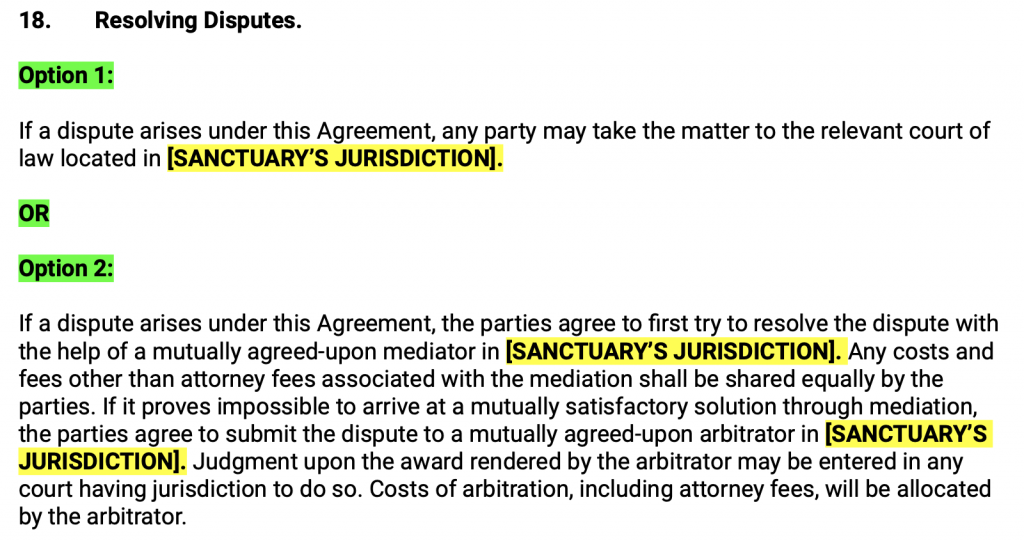
Here again, our template offers you two options to choose from in order to customize it to what fits best with your sanctuary and your independent contractor. One option (the second) contemplates what is known as alternative dispute resolution. The other basically amounts to agreeing that a court in your jurisdiction will be responsible for resolving all disputes.
Go Go Goats: Alternative Dispute Resolution
Go Go Goats and Sally Social have decided that if they have a conflict that they cannot resolve, they would like to pursue Option 2, known as alternative dispute resolution, in lieu of having a court resolve their issues. Because of their friendly relationship, they do not anticipate an issue or dispute arising that they can’t solve together, but in case one does come up, they do not want to put each other through going to court to resolve it.
What is alternative dispute resolution? Simply put, it is any means of resolving a dispute between two parties outside of a courtroom. The most common forms of alternative dispute resolution, or “ADR,” are mediation and arbitration. In the judicial system, ADR has become increasingly more employed as a method of avoiding the expenses of litigation and helping parties come to terms before they go to court.
Typically, mediation is nonbinding, and is a way to get two parties together so that they can sit down and talk through their misunderstandings. In some jurisdictions, especially busy urban ones, you may find that you are mandated to go through mediation before attempting to litigate your issues before a court. You are generally appointed a mediator who serves as a neutral party to help you sort issues out, and come to some kind of shared understanding on how to resolve them.
Arbitration is a bit more formal and is generally binding. In this case, while you may not need to observe the formal rules of procedure and evidence that are used in a court proceeding, there will definitely be more strict guidance when it comes to how and what evidence a party may introduce in a proceeding. Arbitration may be conducted by a single arbitrator, or a team of arbitrators. There is a formal organization of arbitrators that parties to a dispute may contact to hire to arbitrate their disputes. A decision by an arbitrator can be brought to a court of relevant jurisdiction in order to have it enforced.
With both mediation and arbitration, parties must agree on how their neutral third party will be paid. In the Template and Samples we have provided, the parties to the agreements agree to share the costs of their mediator and arbitrator. We also contemplate a two-step process, starting with mediation. If parties cannot resolve their issues with the aid of a mediator, they then can proceed to arbitration, where an arbitrator will make a decision that can be enforced by the courts. This can of course be tailored to your sanctuary’s needs if you for example decide you’d like to skip the mediation step and proceed straight to arbitration.
As drawn-out as this sounds, ADR can often save a lot of expense when it comes to avoiding court filing fees, hiring lawyers, going through the discovery process, and then proceeding to litigation. It is a worthwhile option to consider with respect to any legal disputes a sanctuary may face. It is also worth consulting with your own counsel to find the right option or mix of ADR options that fit your sanctuary’s needs best.
Turkey Love: Going to Court
In contrast, Buddy Birdlover and Belinda Builder have opted for Option 1, the choice to resolve any disputes that may arise in their local courts. In jurisdictions where there is a small claims limitation and system, it is worth looking at what the monetary limits are for resolving issues in small claims courts. Litigation in small claims courts is often less formal and less expensive than litigation involving larger amounts of money, and parties can often appear pro se (without the representation of a lawyer). Note that in busy jurisdictions, even in small claims cases you may be initially referred to court ordered mediation.
Here, Buddy and Belinda don’t really have a relationship outside of their independent contractor agreement, the amount of the contract means that it would fall within small claims jurisdiction and would not require them to get lawyers, and they just decided that having a set course of action of going directly to small claims court in case of a major issue is preferable for both of them.
Note that they have also specifically stated that all disputes should be resolved in their local jurisdiction, which is in Winnemac County, Winnemac. This is an easy call since both Buddy and Belinda are based in Winnemac County. But specifying your home venue is very important! You, as a sanctuary, will definitely want to specify your local jurisdiction. Imagine if you hired an out-of-state independent contractor, and got into a dispute with them that involved them filing a claim in an out-of-state court! That could be a major headache. While specifying your venue is not a guarantee that any disputes will be resolved in your local jurisdiction, it certainly helps!
Section 19: Confidentiality
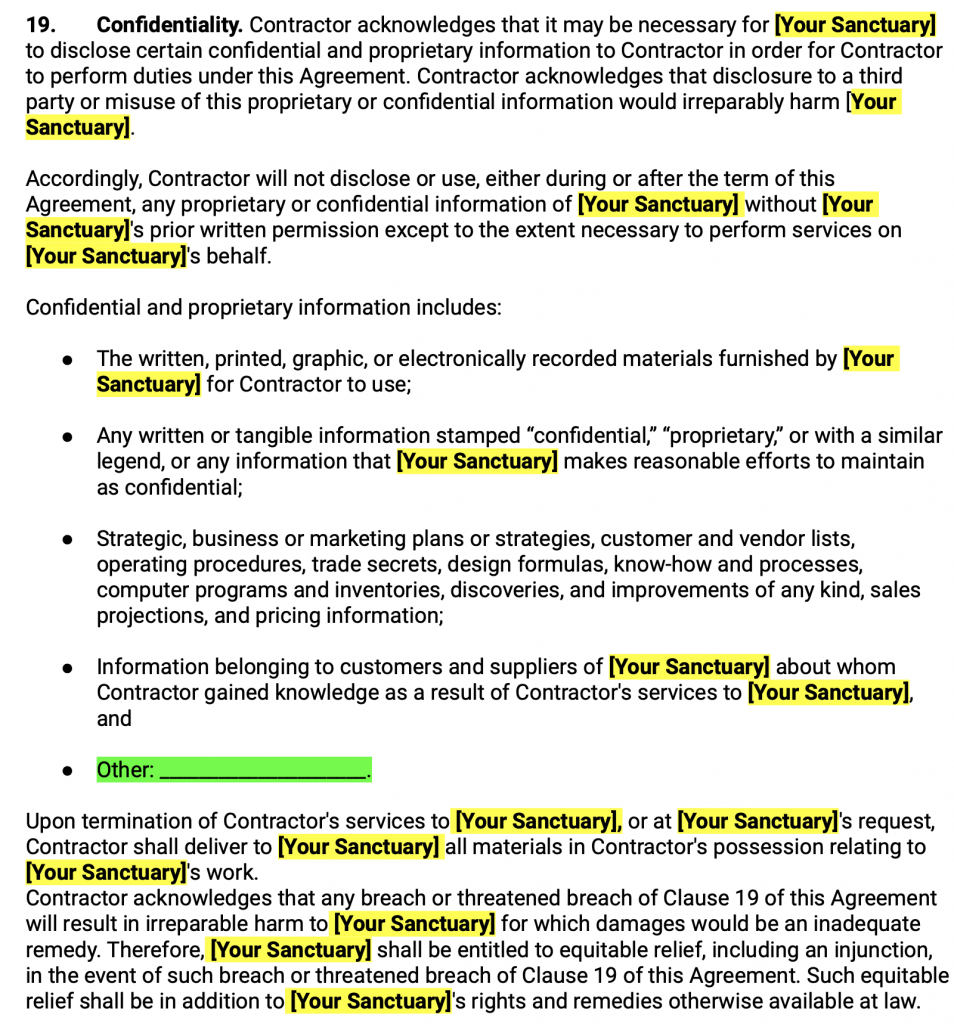
This section can also be seen as “boilerplate,” but it is really important. It has to do with any and all information that is confidential to your sanctuary. In our template, it is drafted generally and broadly in the attempt to cover any kind of situation where “confidential information” might come up. Examples of confidential information might include: delicate information about certain residents’ origins, health information around certain residents, relationships with donors, including those who may wish to be anonymous, donation amounts, relationships with other vendors and contractors, or information about pricing or discounts.
Note that we provide an option where your sanctuary can list any other information that you might be particularly concerned about keeping confidential.
20: Work Product and Associated Proprietary Information

This section deals with the “ownership” of the work product that comes out of your collaboration with your independent contractor. It provides that the product of all work that comes out of your agreement will be the property of your sanctuary. To explain what this means, it may be worthwhile to check in again with Gertie and Buddy.
Go Go Goats and “Work Product”
In the case of Gertie’s agreement with Sally Social, “work product” as contemplated by this provision would mean all photos and narratives taken by Sally during her initial visit, as well as all posts that she makes under the agreement. It also includes any photos that Gertie may take of Sally as she meets and photographs the residents of Go Go Goats. Finally, it entitles Gertie to mention and name Sally in any posts around their work together.
Turkey Love and “Work Product”
When it comes to Buddy’s new turkey enclosure, what this provision means is that all designs that Belinda makes of this enclosure will belong to Buddy, as well as the enclosure itself of course. If Belinda takes pictures of her work in progress, those also can be used by Buddy, as well as any photographs that he might take of her doing her work.
Section 21: No Partnership

While this is also a “boilerplate” provision in an independent contractor agreement, its short length belies its importance. “Partnership” is a legal agreement that has a special meaning. Specifically, it is a legal agreement between two parties to embark on a for-profit business venture that involves the splitting of profits and losses. A partnership agreement can be made either explicitly (as in through a written contract) or implicitly (as in through a handshake agreement or understanding). Therefore it is always important to disclaim forming this kind of relationship explicitly when your sanctuary is coming to a written agreement with any other party.
Section 22: Assignment and Delegation

Assignment and delegation have different meanings in contract law, but both essentially relate to the parties to a contract being able to “pass on” their rights and/or obligations under their agreement to other, third parties. This can become complex quickly. For example, what if your contractor decides to delegate their obligation to fulfill a certain expectation to another party who is not one of their employees, who might not be privy to or bound by all of the background or details of your agreement?
If you or your contractor anticipate a situation where you might want to assign or delegate duties under your agreement, you should definitely speak to your counsel to make sure that you tailor this provision in a way that provides specifically for the rights and/or obligations you DO want to assign or delegate, and not inadvertently create a situation where other unanticipated rights or obligations can be assigned or delegated. In our Template, to keep things simple, we simply provide that neither party has the right to assign or delegate rights duties.
Section 23: Applicable Law

Remember how we talked about the question of specifying your jurisdiction when it comes to adjudicating any disagreements? This was back in Section 18, which dealt with resolving disputes. Believe it or not, the question of WHERE disputes are heard is not the only question you have to deal with when it comes to the matter of how your agreement will be construed in the event of a disagreement.
The provisions in Section 18 have to do with choice of venue, or where geographically a dispute will be heard. There we recommended that you provide in your agreements that your sanctuary selects the venue or jurisdiction in which you are located.
There is yet another geographical issue that has to do with resolving disputes, and while it overlaps and seems similar to the question of choice of venue, it’s a little different. This has to do with “choice of law.” While laws may be similar from state to state with respect to the construction of contracts, they do have variabilities. So you also need to choose what jurisdiction’s law applies to your particular contract. Again, we recommend that you choose the law of the particular jurisdiction where your sanctuary is located. Accordingly, both Go Go Goats, and Turkey Love have chosen to specify in this provision that the laws of Winnemac County, Winnemac will apply to their contracts.
Section 24: Notice

We’re almost there! One more big section to go through before we talk about the execution of the agreement.
Notice is important. It is fundamentally about “official communication” between the parties to a contract and specifically has to do with how parties should send “written notice” to each other. This is relevant to many portions of your agreement, whether it be when Sally was sending Gertie draft media posts to review and approve, or whether it comes to Belinda Builder sending Buddy designs for her proposed turkey house. In those and other sections, you will see that “written notice” is required in order to make anything official. It is also important when it comes to things like Section 17, which addresses modifying your agreement. That Section, for example, specifically provides that “This Agreement may be modified only by a writing signed by authorized representatives of both parties.”
What you need to think about here is what the best way is for both parties to communicate. In both the cases of Go Go Goats and Turkey Love, the parties like email, and decided that this is how they want to send official written notice to each other. Traditionally mail is often an option, but that can be a lot slower, and there are also associated issues with how notice is deemed received. Is it when the mail is sent or received, and what happens when mail is lost? Certified mail is an option, but costs money and also isn’t guaranteed. Email is often a faster solution. You can also make provisions for email or electronic signature. Remember that there can be digital issues as well, so it is good practice to always ask the receiving party to acknowledge receipt of an email when you send one.
Note that it is also important for the parties to know who is authorized to execute any written notice. In general, the party who executed the document is presumed to have authority to execute an amendment, but if you’d like, you can also customize this template to add any other parties you would like to be able to execute a “written notice.” This can be helpful in the case that your sanctuary has to make a decision and the original executor is not available. It is definitely good to make any additional “authorized parties” aware of the agreement and its terms before adding them, however.
Signature Page
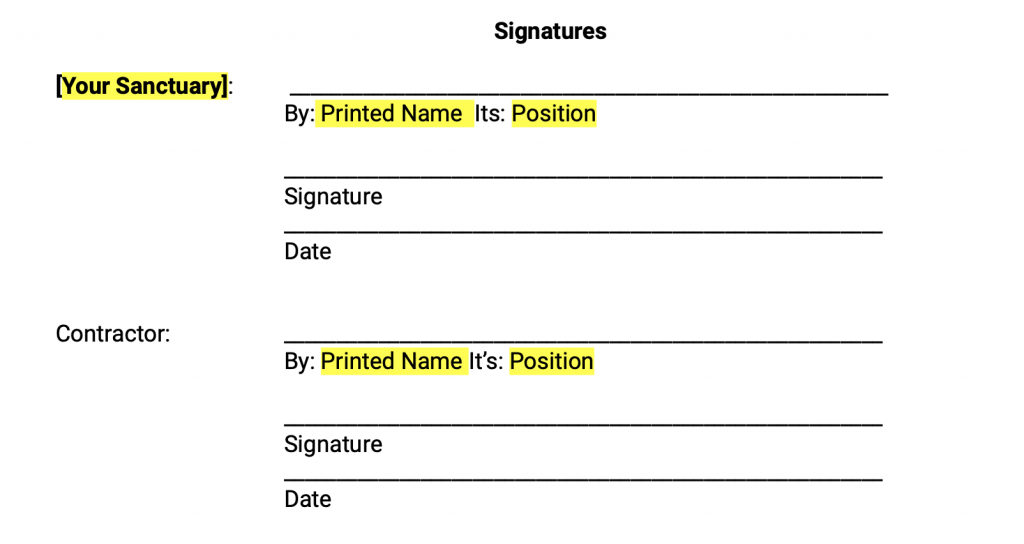
It’s the signature page! You’re almost done! The main thing to note here is that each party, your sanctuary and your independent contractor, has a place to sign the agreement. You should fill in the printed name of each person signing the agreement as well as their position with the organization, and the date! Once this is done, congratulations! You have an executed agreement with your independent contractor! Good luck with your project!
Final Note
As always, we urge you strongly to consult your local counsel when it comes to entering into any binding legal agreements. While we hope that this template and the tools we have offered you here help you to make it easier to understand, negotiate and draft independent contractor agreements, there is no substitute for getting the oversight of local counsel when it comes to your legal contracts with third parties.
Sources And Further Reading
Alternative Dispute Resolution | Legal Information Institute, Cornell Law School
American Arbitration Association
Partnership | Legal Information Institute, Cornell Law School








